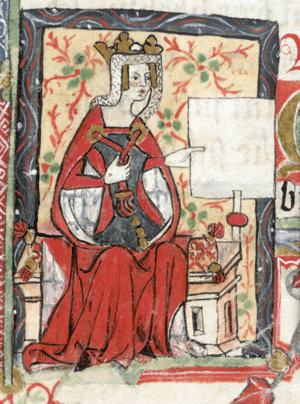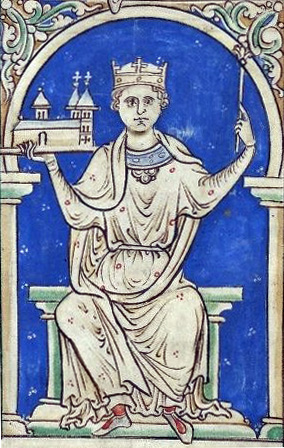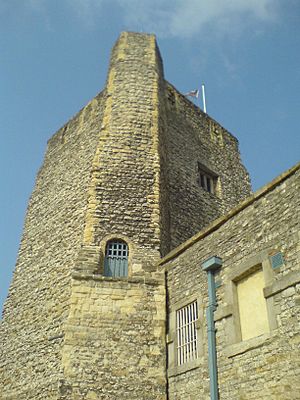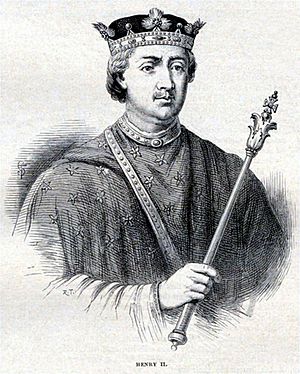Siege of Oxford (1142) facts for kids

The siege of Oxford happened in 1142 during a time called The Anarchy. This was a civil war in England after Henry I of England died without a son to take his place. The war was fought between Henry's nephew, Stephen, and his daughter, the Empress Matilda (also known as Maud). Matilda had recently been forced out of her base in Westminster and chose Oxford as her new main base. Oxford was a very important city back then, almost like a regional capital. It was well-protected by rivers and strong walls. It was also a key location because it sat at a crossroads connecting the north, south-east, and west of England, and it wasn't far from London.
At this point, the civil war was very intense, but neither side could win for good. Both Stephen and Matilda had times when they were ahead, and then times when they fell behind. For example, Stephen was captured by Matilda's army in 1141. But later that year, Matilda's half-brother and main general, Robert, Earl of Gloucester, was captured by Stephen's army. Matilda had been recognized as "Lady of the English" but was soon chased out of London.
Stephen believed that if he could capture Matilda, he would win the war for good. Her escape to Oxford seemed like the perfect chance. He gathered a large army in the north and then moved south. He attacked Wareham in Dorset, a port town that was important to Matilda's side (called the Angevin party). It was one of the few direct links they controlled to Europe. Stephen captured more towns as he moved towards the Thames Valley. Soon, Matilda's only major base outside the south-west, apart from Oxford itself, was Wallingford Castle. This castle was held by her strong supporter, Brian Fitz Count.
Stephen's army reached Oxford in late September 1142. Stories from that time say his army swam across the rivers and waterways to get to the city. Matilda's small group was caught by surprise. Those who weren't killed or captured quickly went inside Oxford Castle. Stephen now controlled the city, which protected his army from attacks. The king knew it would be hard to take the castle by force, even though he used the newest siege technology. He also knew it would be a long wait to starve Matilda out. But after almost three months, the people inside the castle were in a terrible state. They made a plan to help the Empress escape right under Stephen's nose. One evening in early December, Matilda quietly slipped out of a secret door in the wall. Or, as a more exciting story goes, she might have climbed down a rope from St George's Tower. She was dressed in white to blend in with the snow, like camouflage. She passed through Stephen's lines without being caught. She escaped to Wallingford and then to Abingdon, where she was safe. Oxford Castle surrendered to Stephen the next day. The war then continued with many more sieges for another 11 years.
Contents
Why the War Started
King Henry I died in 1135 without a son to take his place. This led to a big problem over who would be the next ruler, known as a succession crisis. His only son, William Adelin, had died in a ship accident in 1120. Henry wanted his daughter, the Empress Matilda, to become queen. However, the rules for a woman becoming queen were not clear back then.
When Henry died, his nephew Stephen of Blois quickly claimed the English throne. Within a few years, fighting broke out, and it became a full-scale rebellion against Stephen. Matilda also claimed the throne, and by 1138, the fight had become a civil war called the Anarchy.
Empress Matilda had recently been forced out of Westminster Palace by angry Londoners. She moved to Oxford in 1141, making it her main base and even setting up her own money-making place there. Before this, she had captured King Stephen and was recognized as "the Lady of the English." Even though Matilda didn't have as much money as the King, both sides likely had armies of 5,000 to 7,000 men.
Oxford's Importance
Oxford was becoming a very important city during this time. It also had a royal castle. The city was valuable not just for its name, but also for its practical use. It was very secure, surrounded by "very deep water" and ditches, as one writer from that time described.
The area where Berkshire and Oxfordshire met was often fought over during the war. Oxford was especially important because it was at the center of the main roads from London to the south-west and from Southampton to the north. Whoever controlled Oxford could control access to London and the north. For Stephen, it was a good place to start attacks on Matilda's strongholds in the south-west.
We don't know how many soldiers Matilda brought to Oxford. She had only a few important supporters with her, enough to keep a "small court." They lived off the lands owned by the royal family nearby. Being so close to London was a "brave move" for Matilda. It probably meant she didn't want to move too far away and planned to take London back later.
Matilda knew she didn't have enough resources to end the war right then. So, she sent her half-brother, Robert, Earl of Gloucester, to her husband, the Count of Anjou. She hoped he would bring his large, experienced army to help her. Matilda and Robert probably thought she would be safe in Oxford until he returned. Robert left for Normandy on June 24th, even though Matilda's situation was "desperate." His absence made her army even weaker.
Matilda considered Oxford her "own town." Stephen had recently been very ill, and people even thought he might die. This made many people feel sorry for him, especially after he was released from Matilda's capture the previous November.
Matilda and Robert didn't know Stephen was getting better. If they had, they might not have sent Robert away. But they didn't know, and Matilda's army was left without its main leader. Matilda might have hoped supporters would come to Oxford to join her cause, but they didn't have to. It's likely that many people were quietly leaving her side. They might have felt they had "bet on the wrong horse" because she hadn't fought hard at Westminster or returned with a strong force. Stephen, on the other hand, had recovered in northern England. He had strong support there and was able to gather a large army, possibly over 1,000 knights, before returning south.
Stephen's Attack on Oxford
After Stephen got better, he acted like a man "awakened as out of sleep." He quickly approached Oxford from the south-west. We don't know the exact size of his army, but he had already won several small but important battles. He had created a path into the south-west, which was controlled by Matilda's side.
He captured the port town of Wareham, which cut off Matilda's communication with her lands in Europe. He also took Cirencester, and the castles of Rampton and Bampton. Capturing these two castles cut off Matilda's communication between Oxford and the south-west. It also opened the road to Oxford for Stephen's return. He likely traveled through places like Sherborne, Castle Cary, Bath, and Malmesbury, which were held by his supporters. He avoided places like Salisbury and Marlborough, which were held by Matilda.
Stephen arrived at the river bank overlooking Oxford on the evening of September 26, 1142. The city was not ready for him. The castle's previous commander had died two weeks earlier, and a new one had not yet been chosen. So, the only soldiers in Oxford were Matilda's personal guards, a fairly small group. They "bravely or foolishly" went out to fight Stephen's army as they crossed the river. They thought they were safe and yelled at Stephen's army from the city walls, shooting arrows across the river.
Stephen wanted to besiege the castle without a big battle, but this meant taking the city first. Stephen's men had to cross several waterways, including an "old, extremely deep, ford." They managed to cross, with at least one writer saying they swam at one point. They entered Oxford the same day through a secret gate. Matilda's soldiers, surprised and outnumbered, panicked and quickly retreated into the castle. Those who were caught were either killed or held for ransom. The city itself was looted and burned. Matilda was now stuck in Oxford Castle with even fewer soldiers than she had arrived with.
Stephen's main goal in besieging Oxford was to capture the Empress, not just the city or castle. Another writer, William of Malmsbury, believed that capturing Matilda would end the civil war in one swift move. Stephen was determined, and "no hope of gain, no fear of loss" would stop him. This was well-known, and it made Robert, Earl of Gloucester, in Normandy, feel even more urgent about his mission.
Oxford Castle had plenty of supplies, so a long siege was expected. But Stephen was "content to endure a long siege to starve out his prey," even though the winter conditions would be terrible for his own men. Stephen was good at siegecraft. He stopped the people inside from finding food by pillaging the surrounding area himself. He also showed cleverness in using different technologies, including belfries (movable towers), battering rams, and mangonels (catapults). This allowed him to attack the city walls both up close and from a distance at the same time.
Stephen didn't hesitate. He set up his main camp in what was later known as Beaumont Palace, just outside the city wall's north gate. It wasn't super strong but was easy to defend with a good wall and gate. He brought up siege artillery and placed it on two man-made mounds called Jew's Mount and Mount Pelham. These were between Beaumont Palace and the north wall. These mounds kept the castle under constant attack, firing at it. They also helped lower the spirits of the people inside. Meanwhile, the King's guards watched for the Empress 24 hours a day.
Because Stephen had taken the city without damaging its walls, the walls now helped him. He could attack Matilda while protecting his own sides. This also made it even harder for anyone to rescue Matilda, as they would have to fight Stephen's army on the strong walls before even reaching the castle. There were supporters about 13 miles away at Wallingford Castle, but they couldn't reach her or help her escape. They probably didn't have enough soldiers to fight the King's army. Matilda's small group was "pinned down" by the royal blockade and eventually started to run low on food.
In December, the Earl of Gloucester returned to England. He brought 300 to 400 men and knights on 52 ships. To please Matilda, her nine-year-old son Henry was allowed to come with the earl. Robert's mission to bring the Count of Anjou and his army to England had failed. Anjou had refused to leave Normandy or try to rescue his wife. Perhaps, it was for the best, as English nobles might not have welcomed him. When Robert returned, he began to besiege Wareham. He probably hoped Stephen would leave Oxford to help Wareham. But Stephen, knowing he had a good position in Oxford, didn't take the bait.
Matilda's Daring Escape
For the second time in the war, Stephen almost captured Matilda, but failed again. After three months of siege, supplies inside Oxford Castle were dangerously low. Matilda and her small group were "cold, starving and almost without hope" inside a burned city.
Matilda, thanks to her soldiers' "ingenuity," escaped from St George's Tower one night in early December. She was with four knights. She managed this because, after such a long siege, some of Stephen's soldiers had left, and others had become less careful. Matilda took advantage of the weaker siege. She might have even been helped by someone on Stephen's side. If not betrayal, then certainly carelessness. In any case, it stopped Stephen from reaching his main goal: to win the war quickly. Matilda's escape to Wallingford added to her reputation for being lucky, almost miraculously so.
Stories about Matilda's escape were made more exciting by people at the time. They wondered how she did it, and chroniclers added details. It was the last and probably most dramatic event of Matilda's life, which was full of dramatic events. One writer, William of Malmsbury, was the first to suggest she escaped through a secret gate and walked to Abingdon. The Anglo-Saxon Chronicle added the idea that she climbed down the walls by rope. The Gesta Stephani added that there was thick snow and the river had frozen. Another writer, Henry of Huntingdon, added that the escapees wore white cloaks.
Some historians suggest that many of these explanations come from old myths or Bible stories that church writers would have known. For example, climbing down a rope from a window was how St Paul escaped his enemies. Walking on water to cross the river sounds like the Israelites crossing the Red Sea. According to Henry of Huntingdon, she was wrapped in a white shawl to blend in with the snow.
This escape was not done without anyone noticing Stephen's guards were not asleep. As she slipped out, there were sounds of trumpets and men shouting, their voices carrying through the frosty air. A recent snowfall helped hide her from her enemies but also made it harder for her to move. However exactly the escape happened, it was clearly well-planned. The castle surrendered the day after Matilda escaped, and Stephen put his own soldiers inside. The siege had lasted over two and a half months.
After her "most remarkable escape," Matilda and her companions went to Abingdon. There, they got horses and supplies. Then they went to Wallingford, where they could rely on the support of Fitz Count, and where they met up with Robert, Earl of Gloucester. Stephen, meanwhile, tried to take back Wareham, which Robert had made stronger after recapturing it. But Stephen's attempt was unsuccessful.
What Happened Next
Oxford was Stephen's "key target" in 1142. Some historians say losing Oxford was a huge disaster for Matilda, like a final stronghold from which retreat would mean the end of her cause. The Gesta Stephani says Stephen now controlled most of the region and the Thames Valley. He already controlled London and the south-east. Now, any hope of Matilda's side succeeding east of the upper Thames valley was gone.
Matilda's escape itself wasn't a victory. If anything, it showed how weak her position was. By the end of the year, Matilda's cause was "on the ropes," and her army was losing hope. This is shown by the fact that even though Robert, Earl of Gloucester, returned from Normandy in late October, it took him until December to get back control of his lands in Dorset.
Wallingford was now the only place Matilda's side held outside of the West Country. Stephen, however, even though he had fought a "brilliant tactical campaign," had lost the momentum he had gained since being released from captivity. He had missed his last chance to end the war for good by capturing Matilda. When she arrived in the west, her group worked to strengthen what they still held, as they could no longer get back lost lands.
There was a popular rumor that Matilda vowed to build a new Cistercian Abbey after her escape. However, some historians think she made this up years later to justify her actions. She didn't actually support building an abbey until 1150.
It's hard to know exactly where Stephen went after the siege. Oxford Castle controlled the area around it, so he probably spent a lot of time and resources bringing the countryside around Oxford under his control. Many nobles in Oxfordshire were loyal to Matilda. Stephen knew Matilda had fled to Wallingford, but he didn't try to stop her. Stephen had tried to besiege Wallingford Castle in 1139, but Fitz Count had made it even stronger over the years and had enough supplies to last for several years. Stephen's earlier siege had failed within weeks, so he clearly didn't want to try again.
The King attended a church council meeting in London the next spring. Around the same time, he returned to Oxford to strengthen his power in the region. Stephen tried a counter attack but was soundly beaten at the Battle of Wilton the following year. Oxford, though, remained in the king's possession. In 1155, the sheriff was given money to help rebuild Oxford, after it had been damaged by Stephen's army 13 years earlier.
Matilda went to Devizes Castle, where she stayed for the rest of her campaign in England. Young Henry, whose role was to give "some small measure of male legitimacy to his mother's struggle," spent the next few months in Bristol Castle before returning to his father in France. Many people who had lost lands in the areas held by the king traveled west to get support from Matilda.
After the siege of Oxford, the military situation became mostly unchanging. The war continued as a "chess-like war of castle sieges." Both sides were struggling because warfare was very expensive, and they weren't good at raising money. Matilda left England in 1148. Stephen died in 1154. Under the terms of the Treaty of Wallingford signed the year before, Henry, Duke of Normandy, became King Henry II of England.






